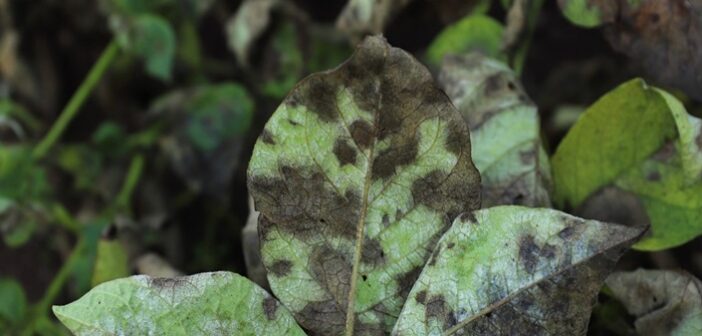Of the nearly 1300 samples submitted by the end of July for ‘Fight Against Blight’ for late blight strain analysis, none have been identified as being the fungicide-resistant EU_43 or EU_46 strains, says Dr David Cooke, senior plant pathologist at the James Hutton Institute.
That’s one positive from a difficult season to control late blight in potatoes. The first UK blight samples arrived at Hutton in April from outbreaks in Kent, with another six samples sent during May.
“That’s early for blight,” David notes. “With a wide range of planting dates, primary inoculum from last season’s unharvested crops and dumps that survived over the winter, blight pressure has been high and made it a difficult season to manage because of crops at different growth stages.”
With dozens of samples arriving more or less every day through June, it has been one of the most intense for early-season outbreaks he has experienced while managing the Fight Against Blight project.
“To some extent, this will have been prompted by our plea for samples to monitor for the new CAA and OSBPI fungicide-resistant strains that have been found on the continent and in Ireland, but obviously, you can only sample blight if it is present,” he says.
Fight Against Blight is only funded to test 400 samples across the season, he notes. “But we don’t like to say no to samples, and you never know when new genotypes will arrive.”
Of the samples genotyped by the end of July, 72% of the population was the aggressive strain EU_36, which has consolidated and spread across much of the country, David reports.
“A further 22% is EU_6, which has been around a long time, while 3% is EU_13. That’s a little bit of a surprise as it has been on a gradual decline for years to the extent we only had one sample a few years ago with this strain.”
EU_41 Danish discovery
The only newer lineage found this year is EU_41. A Danish clone, it was previously found somewhat unexpectedly in a single outbreak in Scotland in 2021 in a Maris Piper crop with no obvious seed connection to the continent.
“This year, we’re finding it in a few outbreaks both in Scotland and south of the border,” David says.
Testing has found that it has insensitivity to metalaxyl fungicides, with discussions wondering whether the strain’s appearance is linked with potato volunteers being sprayed with metalaxyl in carrots.
Metalaxyl is not used much in potatoes currently but could be an option once mancozeb’s approval lapses, David suggests. “The concern is this strain would increase the risk of using metalaxyl in potatoes.”
With continuing problems with the EU_43 and EU_46 strains in northwest Europe and another case in Ireland this season, there should be no let-up in blight programmes for the remainder of the season, UPL’s potato technical expert Geoff Hailstone says.
A key reason, he suggests, for the strains not being detected in the UK so far has been the use of mancozeb with its multi-site activity, mixing at least two actives from different groups in every application, and the alternation of products.
“It’s also important to use products at effective doses to help maintain at least two actives in the growth for sufficient length of time to protect each other,” he notes. “You don’t want to leave one product doing all the heavy lifting, increasing the risk of resistance build up.”
It’s for that reason UPL is recommending using its Proxanil (propamocarb + cymoxanil) blight product at a rate of at least 2.0 L/ha, rather than the historical standard of 1.5 L/ha plus reduced rate of partner. “Managing resistance is so much more important now,” he stresses.
No resistance has been found to either active in Proxanil, with both in different resistance groups and the only member of each group. “It still should be used in a mix. In trials, using it in a mix has given on average 14% better blight control than the partner alone,” he says.
With the risk of the CAA- and OSBPI-resistant strains, Geoff suggests propamocarb is now the only active with reliable anti-sporulant activity.
Anti-sporulants decrease sporangiophore formation, and stop the viability and dispersal of sporangia formed, reducing the spread of disease from the initial infection point, he explains.
“The kick-back activity of cymoxanil controls infections inside plant cells up to two days after the infection takes place,” he adds.
 Towards the end of the season, if growers have any of the maximum four applications available, Proxanil is a very useful partner for products such as Ranman Top (cyazofamid).In Euroblight trials, that combination has provided the best tuber blight control late in the season, Geoff says.
Towards the end of the season, if growers have any of the maximum four applications available, Proxanil is a very useful partner for products such as Ranman Top (cyazofamid).In Euroblight trials, that combination has provided the best tuber blight control late in the season, Geoff says.
“It’s a good place to use that mix with activity on zoospores and tuber blight, with the Proxanil protecting the single site cyazofamid from any potential resistance build-up,” he concludes.




